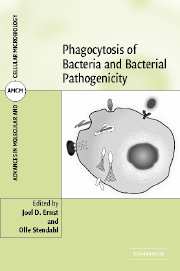Book contents
- Frontmatter
- Contents
- List of contributors
- 1 Introduction
- 2 Phagocytosis: receptors and biology
- 3 Receptor-initiated signal transduction during phagocytosis
- 4 Life, death, and inflammation: manipulation of phagocyte function by Helicobacter pylori
- 5 Phagocytosis of Streptococcus pneumoniae
- 6 Yersinia inhibition of phagocytosis
- 7 Listeria invasion and spread in non-professional phagocytes
- 8 Mycobacterium tuberculosis: mechanisms of phagocytosis and intracellular survival
- Index
- Plate section
1 - Introduction
Published online by Cambridge University Press: 07 August 2009
- Frontmatter
- Contents
- List of contributors
- 1 Introduction
- 2 Phagocytosis: receptors and biology
- 3 Receptor-initiated signal transduction during phagocytosis
- 4 Life, death, and inflammation: manipulation of phagocyte function by Helicobacter pylori
- 5 Phagocytosis of Streptococcus pneumoniae
- 6 Yersinia inhibition of phagocytosis
- 7 Listeria invasion and spread in non-professional phagocytes
- 8 Mycobacterium tuberculosis: mechanisms of phagocytosis and intracellular survival
- Index
- Plate section
Summary
Through their capacity to recognize, phagocytose and inactivate invading microorganisms, phagocytic cells have a key role in the innate immune response and host defense. During this process there is an intimate interplay between different recognition mechanisms displayed by both the host cells and the microorganisms. Understanding the complex process of phagocytosis requires insight into the mechanisms of receptor function, signal transduction, actin-based movements, membrane and vesicle trafficking, and oxidative activation, as well as how pathogens interfere with and subvert these processes. The complexity is thus in part due to the diversity of receptors capable of stimulating phagocytosis, and in part due to the capacity of different microbes to influence their own fate, as they are recognized and internalized. It is now evident that pathogens are not passive bystanders evading phagocytosis and intracellular killing, but have evolved specific means of subverting the process of phagocytosis through different mechanisms, involving inhibition of opsonization and receptor recognition, inactivation of specific GTPases, dephosphorylation, inhibition of PI-3 kinases, and actin polymerization. Studies of the pathogenicity strategies of bacteria such as Salmonella, Helicobacter pylori, Streptococcus pneumoniae, Shigella, Mycobacterium tuberculosis, Yersinia pseudotuberculosis, and Listeria monocytogenes have not only shed light on microbial pathogenicity but have also been useful tools for elucidating the phagocytic process per se. Understanding how Listeria escapes from the phagosome by forming an actin-rich tail has revealed how actin polymerization is initiated and controlled.
- Type
- Chapter
- Information
- Publisher: Cambridge University PressPrint publication year: 2006



